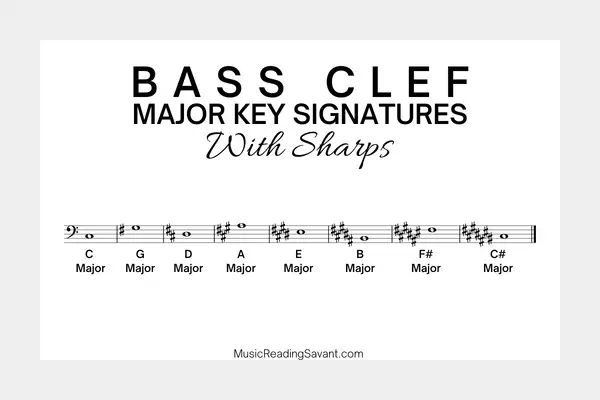Did you know that bass clef signatures are similar to treble clef key signatures?
Yes, they are!
Let me show you how.
Bass Clef Key Signatures
The bass clef key signatures have seven major flat keys that are the same as the seven minor flat keys, and seven major sharp keys that are the same as the seven minor sharp keys. When you add the only major and minor key without flats or sharps, there is a total of fifty-eight key signatures. This is similar to the treble clef key signatures.
The bass clef key signatures can also be divided into two groups; 1) the sharp keys, and 2) the flat keys.
Bass Clef Sharps and Flats
The bass clef sharps and flats written in the key signatures appear in a specific order. Since the order of sharps and flats never change in a key signature, it’s easy to memorize. This also makes it simple to remember the sharp and flat keys.
Where is the Key Signature Located?
The key signature is located right after the clef sign at the start of a piece of music, but it can be found anywhere within the score. You will always find it at the beginning of a staff or after a double bar line to indicate a change of key. The sharps and flats of a key signature are grouped in a specific way to represent major and minor keys.
What is the Purpose of Key Signatures in Music?
The purpose of key signatures is to make writing and reading music easier. All sharps or flats used in a scale or piece are found directly after the clef sign. This area, called the key signature, shows what notes will be sharped or flatted every time they appear throughout an entire song.
Since we are focusing on the bass clef, all the key signatures shown below are found after the bass clef symbol on the staff.
Bass Clef Sharp Key Signatures
There are a total of seven bass clef sharp key signatures. They are G Major or e minor, D Major or b minor, A Major or f# minor, E Major or c# minor, B Major or g# minor, F# Major or d# minor, and C# Major or a# minor.
Let’s look at the major key signatures in the bass clef first with sharps.
Bass Clef Major Key Signatures With Sharps
A total of seven bass clef major key signatures have sharps. These include G Major (1 sharp), D Major (2 sharps), A Major (3 sharps), E Major (4 sharps), B Major (5 sharps), F# Major (6 sharps), and C# Major (7 sharps).

Bass Clef Major Sharp Key Signatures Chart
Here is a chart showing all eight major key signatures with their corresponding sharps in the bass clef. This list makes it much easier to visually understand and remember.
| Bass Clef Major Key Signatures | Total Number of Sharps | Order of Sharps |
| C Major | 0 Sharps | |
| G Major | 1 Sharp | F# |
| D Major | 2 Sharps | F#, C# |
| A Major | 3 Sharps | F#, C#, G# |
| E Major | 4 Sharps | F#, C#, G#, D# |
| B Major | 5 Sharps | F#, C#, G#, D#, A# |
| F# Major | 6 Sharps | F#, C#, G#, D#, A#, E# |
| C# Major | 7 Sharps | F#, C#, G#, D#, A#, E#, B# |
Now let’s take a look at the minor key signatures with sharps in the bass clef.
Minor Bass Clef Key Signatures With Sharps
There are a total of seven bass clef minor key signatures with sharps. These include e minor (1 sharp), b minor (2 sharps), f# minor (3 sharps), c# minor (4 sharps), g# minor (5 sharps), d# minor (6 sharps), and a# minor (7 sharps).
Just like the major bass clef key signatures, only one minor key signature in the bass clef has zero sharps. That key is a minor.
Notice that all of the sharps listed above follow the order of sharps. Now, take a closer look at how they appear on the music staff.
The sharps follow the same order on the music staff with the inside box of the tic-tac-toe symbol centered on the same exact line or space every time.
The F# will always be located on the fourth line, the C# in the second space, the G# in the fourth space, the D# on the third line, the A# in the first space, the E# in the third space, and the B# on the second line.
Also notice how the sharp keys follow a pattern of being five notes apart from each other. To help you see this, start on G (1 sharp) and move to D (2 sharps).
By doing this, you are moving forward through the musical alphabet every five notes. In music theory, this is known as the circle of fifths.
The Bass Clef Flat Keys
We also have a total of seven flat keys in the bass clef. They are: F, Bb, Eb, Ab, Db, Gb, and Cb.

F = 1 flat, Bb
Bb = 2 flats, Bb and Eb
Eb = 3 flats, Bb, Eb and Ab
Ab = 4 flats, Bb, Eb, Ab and Db
Db = 5 flats, Bb, Eb, Ab, Db and Gb
Gb = 6 flats, Bb, Eb, Ab, Db, Gb and Cb
Cb = 7 flats, Bb, Eb, Ab, Db, Gb, Cb and Fb
Again, all of the flats listed above follow the order of flats. This can be found on the music staff too.
You will always find the flats listed in the same order on the music staff with the little belly of the flat symbol centered on the same exact line or space.
The Bb is always located on the second line, the Eb in the third space, the Ab in the first space, the Db on the third line, the Gb on the bottom line, and the Cb in the second space.
In looking at the flat keys listed above, notice how the flats move forward through the alphabet every four notes. If you start at the top (F) and move down (to Bb, Eb, etc.) you will see how this works.
Now, go backward starting with Cb and work your up (to Gb, Db, etc.). The notes move forward every five notes through the musical alphabet.
This is similar to the sharps listed above, except with the sharps you have to start with G and move down to get the same result.
So, why do the sharps and flats appear on the music staff, in the same way, every time? To help you see at a glance what is in your key signature. This speeds up the reading process by quite a bit.
Music Bass Clef Reading Practice
Try memorizing all of the bass clef key signatures this week. Having them available in your memory comes in very handy when reading music.
Make some flashcards or practice by drawing them out on a piece of paper. Maybe you could look at several pieces of music and try naming the sharps and flats in the key signatures.
However way you practice reading doesn’t matter as long as it is effective.

My name is Dennis Williams I’m a student at Full Sail University – aside from that I’m a Professional DJ and a Music Producer. Here the thing I never took a music lesson after my 1st experience with a teacher who told me I was tone deaf and sad to say for many years I believed it only to find out there is no such thing. Any way my point is although i was told I wouldn’t need any music back ground to be successful in this school but now that I’m in my last year I find that hard to believe because theory of music is a concept all its own. I need help with that. I’ve made music for many years very impressive pieces but I alway composed it buy ear. Now I realize there is much more to it then the sound there off. Teresa if at all possible I’d be honored to work something out in accord to gaining needed insight of your knowledge there of. Thank you Dennis Williams
Hi Dennis! So glad to have you here! I am very sorry that you had a teacher that made you believe a lot of false information. Unfortunately, there are a lot of those and it is so important for everyone to know the truth. I’ve never met a person who does not have the ability to learn how to read and play music (and I have coached all ages and all walks of life).
Reading music is basically music theory. In order to understand how to write music well, music theory is the foundation also. It really isn’t hard to learn, but it does require a little time and work. It sounds like you have a very strong ear, so adding the reading component to your overall abilities will really set you apart from the rest of the pack and give you unlimited potential!
I have been thinking about adding a service where I give private lessons over the phone on music theory/music reading/music writing. If this is something you are interested in, please email me through the contact page and we can discuss how to arrange this.
I can teach you several lessons in an hour (or even a half-hour) and help you learn how to practice those concepts effectively in order to learn them deeply, yet quickly. With the right tools & resources, it can be done!
HI, JUST LEARNING THE BASS CLEF…..I NOTICE..FOR EXAMPLE ITS SHOWING A FLAT
AS 3 FLATS……..THOUGHT IT WAS 4 ! ?
Thanks for pointing out that mistake. I have fixed it. Thanks!
Teresa, thank you for simplifying an otherwise daunting task. Many of us are isolated or unable to afford music lessons. I studied cello for eight years, but sacrificed both my cello and my playing for forty years to give my children private piano lessons. This year my husband gave me a gift of a cello for Christmas. I’ve forgotten so much and after two hand reconstructive surgeries, requiring six months in hard casts, I am rediscovering my love of cello. Your information and encouragement is so welcome!
Teresa, I have not played my trombone for 50 years. Both for enjoyment and respiratory therapy I am once again relearning my horn and music. I have been trying to grasp the flats and sharps so I can again retrain my ears to identify them as I relearn to play them. Your webpage on the bass clef sharps and flats have helped me immeasurably. Now to pick up the horn and practice.
Thanks so much this really helped me. I am a self taught bass guitarist and I needed to learn these for rock ensemble at my school
Easy way to name a key signature I was taught, for flats it’s the next to last flat that is the key name, e.g. 3 flats – Bb, Eb and Ab. Next to last flat is Eb. That’s the key. (You’ll just have to remember no flats is C , and one flat is F.!!)
For sharps look at the last Sharp and add half a tone (one note) se.g. if there’s 1 Sharp in the key (F#), the next note up is G. That’s the key.
3 sharps, F#, C#, and G#, last Sharp is G#. Go up to next note A. Key of A. #simples
The bigger truck is someone saying your in Eb and knowing which three flats that is. #canthelpyouwiththat
this is very helpful thanks so much
can you please help me with this I don’t understand, I play the trombone and struggle learn the notes for every key signature.